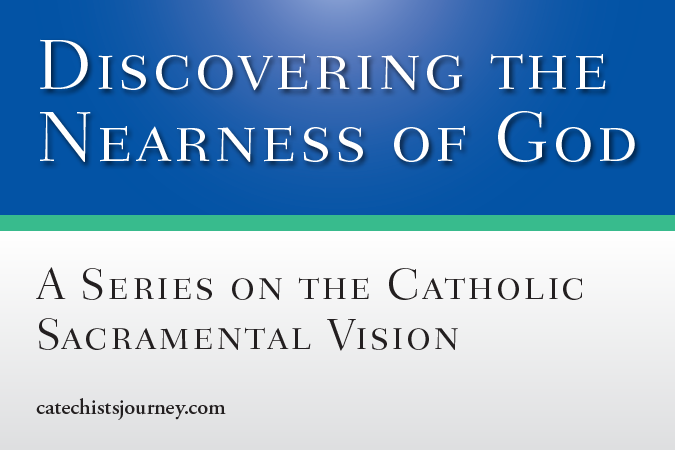
Welcome to the first installment of an eight-week series I’m doing this summer here on Catechist’s Journey on the Catholic sacramental vision. “Discovering the Nearness of God” will draw from my book, Living the Sacraments: Finding God at the Intersection of Heaven and Earth.
I’d like to begin by stating emphatically that the most urgent message for us to spread today is the good news of the nearness of God! We live during a time when people are being bombarded by realities that trigger despair. The recent spat of tragic celebrity suicides not only reminds us of the brokenness and fragility of our world but is also illustrative of the fact that too many people are walking around with narratives of despair, fear, isolation, loneliness, and worthlessness in their heads. In short, they feel abandoned.
This was the experience of the Jewish people in exile—they felt abandoned by God. Even upon their release from exile, they returned to a destroyed homeland (including their Temple), exacerbated by the presence of an occupying power. For all intents and purposes, the exile of the Jewish people never ended—that is, until Jesus came along and announced that it was over! The Good News that Jesus proclaimed was simply that God had drawn near to his people. This simple message, however, was—and is—the basis of a change in narrative, from one of abandonment and despair to one of joy and hope.
The work of evangelization and catechesis is to announce and draw attention to the nearness of God in our everyday lives. In short, we are called to change the prevailing narrative from one of fear, despair, isolation, and worthlessness to one of assurance, hope, and joy that can only come from living in the palm of the Lord’s hand. The narrative we proclaim can be summed up with three Rs:
- Rescue—The story of salvation history is a story of God rescuing his people from bondage: first, from the bondage of slavery in Egypt and, eventually, from the bondage of sin through the life, Death, and Resurrection of Jesus Christ.
- Restoration—God continually restores us to right relationship with him and with one another.
- Reassurance—God’s saving grace continues to be present to us through the presence of the Holy Spirit and the Church and, in particular, the sacraments.
This simple yet profound narrative became flesh in Jesus, Emmanuel, or “God with us.”
So how do we change people’s narratives? You might be surprised to know that it is not accomplished primarily through rational debate, concisely defined doctrines, or apologetics, as important as these may be. Rather, the most powerful weapon we have for changing people’s narratives is our sacramental life: signs, symbols, and rituals. Symbolic or ritual actions and objects can be thought of as the enactments or embodiments of a narrative: simply put, they tell a story. When a child falls and scrapes a knee, he or she enters into an experience—a narrative—that is unfamiliar: pain and fear. When Mommy or Daddy kisses the scrape, the child is brought back into a familiar narrative: one in which the child knows he or she is loved, cared for, protected, and accompanied by a parent who will not let the pain prevail. As a result, the child feels comforted, gains strength and courage, and even learns to laugh at the event. Kissing it really does make it better. All ritual actions accomplish the same result: they enact a narrative.
Every time we pour water, anoint with oil, lay our hands over someone, light a fire, break bread, make the Sign of the Cross, pray the Rosary, or put on a scapular, we invoke a narrative of rescue, restoration, and reassurance—a narrative that stands in opposition to the all-too-prevalent realities of pain and loss, emptiness and brokenness, and isolation and loneliness that often creep into our lives like seepage through a crack in the foundation of our home.
Every sacrament of the Church, every ritual, every sacramental object tells our story and enacts our narrative. A ritual action that fails to do this rings hollow. On the other hand, when these rituals are celebrated fully and robustly, they make manifest a narrative of Good News: we are rescued, restored, and reassured! The Catholic vision, then, is one that recognizes God as being present in the world—a sacramental vision. According to St. Ignatius, if we human beings adjust our vision, we should be able to find and recognize God in all things. It is through the sacraments of the Church that we are continually called back to this life-saving narrative that reassures us of God’s nearness and undying love for us.




Be the first to comment